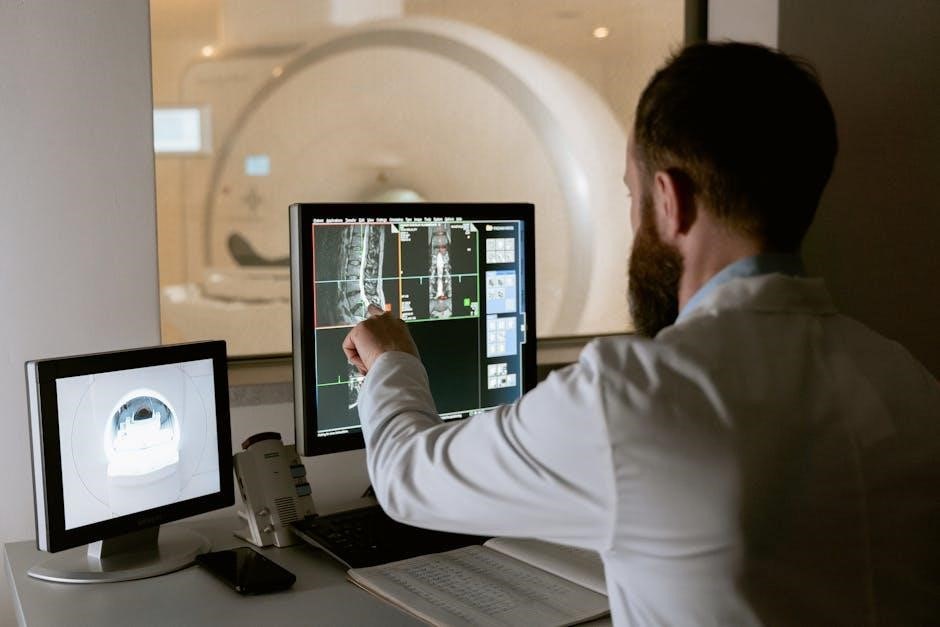Cells are the basic structural and functional units of life, essential for understanding biology and medicine. Studying cells reveals how organisms function, grow, and respond to stimuli.
1.1 Definition and Importance
A cell is the smallest unit of life, serving as the structural and functional basis of all living organisms. It consists of a nucleus, cytoplasm, and membrane, each performing vital roles. Cells are essential for growth, reproduction, and maintaining life processes. Their importance lies in their ability to adapt, respond to stimuli, and specialize, enabling complex biological systems to function. Understanding cells is crucial for advancing medicine, genetics, and biotechnology, as they hold the key to addressing diseases and developing innovative therapies. Studying cells provides insights into life’s fundamental mechanisms, making them central to biological and medical research.
1.2 Brief History of Cell Discovery
The discovery of cells dates back to 1665 when Robert Hooke first observed cork tissue under a microscope, coining the term “cell.” Later, Antonie van Leeuwenhoek revealed microorganisms, expanding cellular knowledge. In 1839, Matthias Jakob Schleiden and Theodor Schwann proposed the cell theory, unifying cell concepts across organisms. Rudolf Virchow later added that all cells arise from pre-existing cells, solidifying the theory. These milestones laid the foundation for modern cell biology, enabling deeper understanding of life’s structural and functional units. Historical advancements in microscopy and theory have been pivotal in unraveling cellular mysteries, driving scientific progress and medical breakthroughs.
Structure and Function of the Cell Membrane
The cell membrane is a thin, semi-permeable layer protecting the cell and regulating the movement of materials. Its fluid mosaic model includes a phospholipid bilayer and embedded proteins.
2.1 The Fluid Mosaic Model
The fluid mosaic model describes the cell membrane as a dynamic, flexible structure composed of a phospholipid bilayer embedded with proteins. These proteins perform various functions, such as transport and signaling. Cholesterol molecules are also present, influencing membrane fluidity. The model highlights the membrane’s ability to change shape and allow movement of molecules, maintaining cellular homeostasis. This structure is essential for cell communication, nutrient absorption, and waste removal, showcasing the membrane’s critical role in cellular processes.
2.2 Membrane Transport Mechanisms
Membrane transport mechanisms are essential for moving substances in and out of cells. Passive transport, such as diffusion and osmosis, relies on concentration gradients and requires no energy. Facilitated diffusion uses membrane proteins to assist molecule movement. Active transport, like the sodium-potassium pump, moves substances against concentration gradients using ATP. Vesicular transport involves engulfing or releasing substances through membrane vesicles. These mechanisms ensure proper nutrient uptake, waste removal, and maintenance of cellular homeostasis. Understanding transport mechanisms is crucial for grasping cellular function and survival.

The Cell Nucleus and Its Role
The cell nucleus acts as the control center, storing genetic material and regulating gene expression. It directs cellular activities, including growth, metabolism, and reproduction, ensuring proper cell function.
3.1 Structure and Components
The cell nucleus is enclosed by a double membrane called the nuclear envelope, which regulates the flow of materials. It contains nuclear pores (nucleoporins) for selective transport. The nucleus houses chromatin, a complex of DNA and proteins, organized into visible chromosomes during cell division. The nucleolus, a distinct region within the nucleus, is responsible for ribosome synthesis. These components work together to store genetic material, regulate gene expression, and manage cellular processes, making the nucleus a critical hub for cell functionality and survival.
3.2 Role in Gene Expression
The nucleus plays a central role in gene expression by controlling the transcription of DNA into RNA. It regulates which genes are active and when, ensuring proper cellular function. Transcription occurs in the nucleus, where RNA polymerase and transcription factors bind to DNA. The nucleus also processes RNA, adding caps and poly-A tails before exporting it to the cytoplasm for translation. Chromatin structure within the nucleus influences gene accessibility, with tightly packed regions (heterochromatin) being less active and loosely packed regions (euchromatin) facilitating transcription. This regulation ensures genes are expressed accurately and efficiently, maintaining cellular health and function.

Functions of Cell Organelles
Cell organelles perform specialized functions essential for cell survival. Mitochondria generate energy, the endoplasmic reticulum processes proteins, and ribosomes synthesize proteins, each contributing to cellular operations.
4.1 Major Organelles and Their Functions
Major cell organelles include the nucleus, mitochondria, endoplasmic reticulum, ribosomes, lysosomes, and golgi apparatus. The nucleus stores genetic material, while mitochondria produce energy through cellular respiration. The endoplasmic reticulum synthesizes proteins and lipids, ribosomes produce proteins, and lysosomes degrade cellular waste. The golgi apparatus modifies and transports proteins and lipids. Each organelle plays a vital role in maintaining cellular homeostasis and enabling specialized functions, ensuring the cell operates efficiently as a functional unit.
4.2 Importance in Cellular Processes
Cell organelles are crucial for maintaining cellular homeostasis and enabling specialized functions. They regulate energy production, protein synthesis, and waste management, ensuring proper cell operation. Organelles like mitochondria and the endoplasmic reticulum are vital for metabolism and cellular signaling, while lysosomes and the golgi apparatus handle degradation and transport of molecules. These processes are essential for cell growth, division, and response to external stimuli. Understanding organelle functions is key to advancing medical research, particularly in diseases like cancer and neurological disorders, where cellular dysfunction plays a central role. Their importance underscores the need for continued study in cell biology.

Cell Division Processes
Cell division is essential for growth, repair, and reproduction, involving mitosis and meiosis. It ensures genetic continuity and proper cellular function, crucial for understanding genetics and medicine.
5.1 Mitosis and Meiosis
Mitosis and meiosis are fundamental processes in cell division. Mitosis involves the division of a cell into two genetically identical daughter cells, crucial for growth and tissue repair. It consists of phases like prophase, metaphase, anaphase, and telophase, ensuring precise chromosome distribution. In contrast, meiosis is specialized for reproductive cells, producing four genetically diverse daughter cells through two successive divisions. This process introduces genetic variation, essential for evolution. Both mechanisms ensure cellular continuity and diversity, playing pivotal roles in life’s continuity and adaptability.
5.2 Regulation of the Cell Cycle
The cell cycle is tightly regulated to ensure proper cell division. It progresses through phases G1, S (DNA synthesis), G2, and M (mitosis). Checkpoints at each phase ensure DNA integrity and proper progression. Cyclins and cyclin-dependent kinases (CDKs) drive the cycle forward. Tumor suppressors like p53 and Rb halt the cycle if issues arise. Dysregulation can lead to uncontrolled growth, contributing to cancer. Understanding these mechanisms is crucial for developing cancer treatments and appreciating cellular homeostasis.

Transport Mechanisms Across the Membrane
Transport mechanisms are essential for cellular function, enabling the movement of molecules. Passive transport relies on diffusion and osmosis, while active transport uses energy and proteins. Vesicular transport handles larger molecules, maintaining cellular homeostasis.
6.1 Passive Transport
Passive transport is the movement of molecules across a cell membrane without energy input, driven by concentration gradients. Diffusion, osmosis, and facilitated diffusion are key types. Simple diffusion involves molecules moving directly through the lipid bilayer, while facilitated diffusion uses carrier proteins. Osmosis specifically refers to water molecules passing through the membrane. These processes are crucial for nutrient uptake and waste removal, maintaining cellular balance efficiently without ATP consumption. They ensure essential substances are distributed naturally, vital for cellular survival and function. Passive transport exemplifies nature’s energy-saving mechanisms, optimizing resource distribution within cells.
6.2 Active Transport and Vesicular Transport
Active transport requires energy (ATP) to move molecules against their concentration gradient, crucial for maintaining cellular ion balance. Vesicular transport involves vesicles to transfer large molecules or cellular components. Active transport uses carrier proteins to pump substances like ions and nutrients into or out of cells. Vesicular transport includes exocytosis (releasing materials) and endocytosis (absorbing materials). Both mechanisms are vital for cell signaling, nutrient distribution, and waste removal. They ensure cells acquire essential resources and communicate effectively, playing a critical role in maintaining cellular homeostasis and specialized functions. These processes highlight the cell’s dynamic and energy-driven operational systems.
Applications of Cell Biology
Cell biology advances medicine, aiding in disease diagnosis, drug development, and gene therapy. It helps understand cancer, nerve cell function, and develops treatments, improving global health significantly.
7.1 Medical Applications
Cell biology significantly impacts medicine, advancing cancer research and chemotherapy effectiveness. Understanding cell function and signaling aids in developing targeted therapies and regenerative medicine. Insights into nerve cell behavior and gene expression enable better treatments for neurological disorders. Stem cell research offers potential for tissue repair and personalized medicine. These advancements improve disease diagnosis, drug development, and overall patient care, highlighting the critical role of cell biology in enhancing global health outcomes and saving lives.


















































